The Ryman Auditorium and Architecture of Middle Tennessee
Nashville has seen unprecedented growth in recent decades, and the city continues to wrestle with questions about the preservation of its historic structures. A new reissue of Architecture of Middle Tennessee—now available from Vanderbilt UP—revisits and expands upon a book that wrestled with similar questions almost half a century ago.
When it was first published in 1974, Architecture of Middle Tennessee served as a record of some of the region’s most important and most endangered buildings. Based primarily upon photographs, measured drawings, and historical and architectural information assembled by the Historic American Buildings Survey of the National Park Service in 1970 and 1971, the book was conceived of by editors Thomas B. Brumbaugh, Martha I. Strayhorn, and Gary G. Gore as a record of buildings preservationists assumed would soon be lost. Remarkably, though, nearly half a century later—and in a city whose skyline has been filled with construction cranes in recent years—most of the buildings featured in the book are still standing today.
In her foreword to this new reissue, Aja Bain discusses why these buildings were saved and what lessons the book offers to us about preservation now:
The book itself, then, is an artifact, a snapshot of the preservation ideals of the country on the cusp of the Bicentennial and its subsequent history and nostalgia boom. It is also a time capsule of our region (but primarily Nashville) at the transitional moment when it was redefining its role in the New Sunbelt South and its relationship to the past. [. . .]
Architecture of Middle Tennessee is a microhistory of the preservation field itself, with all its shifting biases, prejudices, and assumptions. It is a lens through which to view the evolution of preservation ideals and practices in our region and a roadmap for measuring how far we’ve traveled. It’s a behind-the-scenes look at history production and the way societies construct a past that suits them through the built landscape. It’s a potent manifestation of the dangers of survival bias. It’s both a warning and a catalyst for hope.
Bain highlights Nashville’s famous Ryman Auditorium in particular, and its surprisingly precarious status at the time of the book’s original publication in 1974:
Architecture of Middle Tennessee also functions as a cautionary tale for readers, many of whom will be alarmed and incredulous to learn that buildings like the Ryman Auditorium were ever in danger of being razed. But it’s true: when a new state-of-the-art home for the Grand Ole Opry was being constructed, many felt the old-fashioned Ryman had become obsolete. Today, of course, it’s the most iconic structure in the state and a world-famous performance venue, but in 1974, Music City’s crown jewel was seen as a relic that should make way for progress. [. . .]
Today we’ve built a multi-billion-dollar tourism empire on our musical legacy, but in the 1970s we were almost the town that tore down the Ryman. And we don’t appear to have learned from it: in just the past few years, we’ve almost taken down Studio A. We continue to decimate Music Row, declared a National Treasure in 2015. And we almost built condos on a UNESCO Site of Memory in Fort Negley Park. This work makes a strong case for re-examining our hubris.
Brumbaugh’s book is a powerful reminder that preservation is never guaranteed, even for structures that, in hindsight, have obvious significance and value.
Read on for Architecture of Middle Tennessee’s exploration of the Ryman Auditorium:
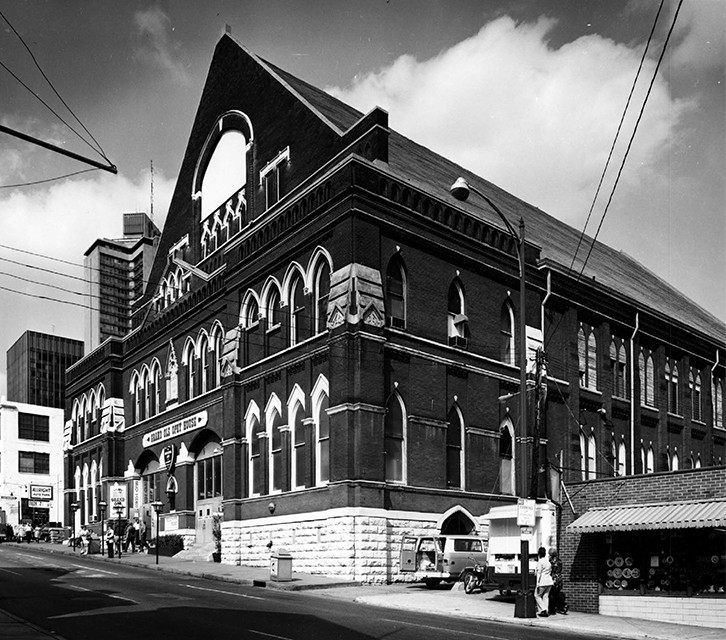
Ryman Auditorium
The red brick bulk of the Ryman Auditorium at 116 Opry Place (116 Fifth Avenue, North) occupies a quarter of a block in downtown Nashville. It was originally called the Union Gospel Tabernacle and was renamed the Ryman Auditorium in 1904, in honor of Captain Thomas Green Ryman, who perhaps did more to make the building a reality than did any other individual. Since 1941, the Ryman has been the home stage of Nashville radio station WSM’s Saturday night country music show, the Grand Ole Opry. As a result, the big auditorium has been familiarly known, for a long time, as the Grand Ole Opry House—a name that became official in 1963, when the building was bought by the National Life and Accident Insurance Company, of which WSM is a subsidiary.
The deteriorating downtown area where the Ryman stands is also the city’s most interesting and architecturally significant district. The five blocks from Opry Place to the Cumberland River contain the most important late-nineteenth-century commercial properties—warehouses and stores—which still survive in Nashville.1 Itself a combination of both architectural and cultural history, the Ryman was placed on the National Register of Historic Places in 1971.
Although it was not built to serve either as an opera house or as a legitimate theater, the Ryman, with its excellent acoustics and one of the biggest stages in show business, has, through the years, presented one of the country’s most distinguished rosters in the performing arts and has earned a national reputation.
The idea for the auditorium took shape in 1885. Construction began in 1888, and the building was completed in 1892, at an estimated cost of $100,000. Contributions from citizens of Nashville paid part of the building cost; part of it came through fund-raising committees; part came from the continuing efforts of Captain Ryman and the Reverend Sam Jones.

Ryman was a riverboat captain, owner of several steam packets whose operation along the Cumberland River had made him wealthy. Jones was a professional revivalist whose great influence and large following throughout the South drew enormous crowds to his powerful, emotion-packed sermons. In May 1885, Captain Ryman and his men came ashore in Nashville to look in on a revival meeting that Jones was holding in a tent at Broad and Spruce streets. Their customary practice on such outings was to harass the revivalist and break up the meeting. Records differ about the subject of Jones’s sermon that day; some say that his topic was “Mother”; some say “Whiskey.” Accounts agree, however, that it was a rousing sermon. It made an immediate and devoted follower of Tom Ryman, who promptly closed the bars on all his steamers, confiscated the liquor, converted his big dockside saloon to a religious meeting hall, and began a vigorous campaign to build an auditorium for Jones to preach in. Ryman gave generously of his own money for the proposed tabernacle and worked tirelessly to raise funds from other sources. In 1888, Sam Jones again came to Nashville to hold a revival, and $22,000 contributed at his final sermon went into the Tabernacle Fund.
The hand-cut limestone foundation was laid that summer. On February 25, 1889, a charter of incorporation registered with the State of Tennessee gave the Union Gospel Tabernacle as the name of the proposed building and the promotion of religion and morality as its purpose.
On March 25, 1890, with the walls of the unfinished Tabernacle six feet high and canvas stretched across the top for a roof, the Reverend Sam Jones held the auditorium’s first meeting. For the next decade, Jones helped raise money to pay off the debt on the building which his zeal had inspired. Architect A. T. Thompson, who designed the Tabernacle, and a number of the men who helped build it worked for less than their usual rates as a contribution to the enterprise. The people of Nashville continued to give money for it at revival meetings and through various organizations. In 1900, it was announced that a single individual, Captain Tom Ryman, had carried forward the building debt and the interest on it.2
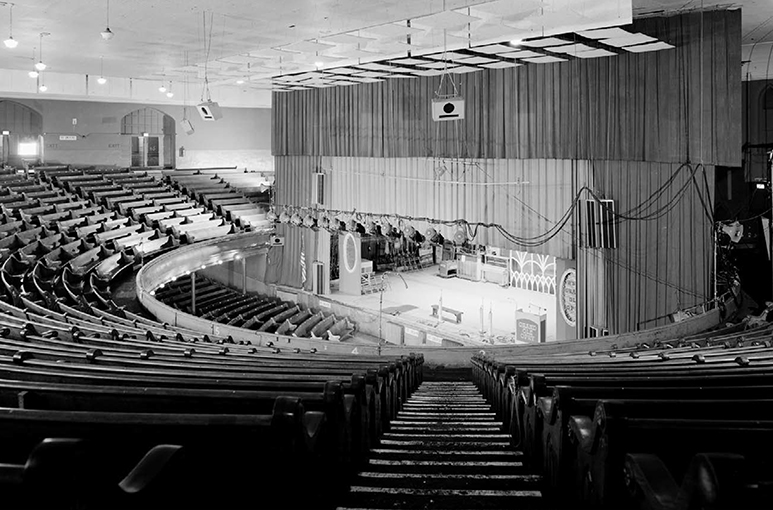
Though original plans had included a balcony which would enable the building to seat 6,000, the new Tabernacle consisted at first of a ground floor only, accommodating approximately half that number. Curved wooden pews surrounded a pulpit and a small platform. There was no stage.
Preparing for the Tennessee Centennial Celebration in Nashville in 1897, many state organizations planned annual conventions in the capital to coincide with the celebration. When the biggest group of all, the Confederate Veterans Association, announced that it would convene at the Tabernacle and that 60,000 to 100,000 members would probably attend, it became clear that the building would need full seating capacity. The veterans’ convention was scheduled for June 1897; the new balcony, anchored on steel columns extending to the basement, was completed in late May, and the Union Gospel Tabernacle became the South’s largest assembly hall.3 After the convention, the Confederate Veterans Association donated money to pay for the balcony, known since then as the Confederate Gallery.
Since public funds went into the building’s construction, Nashvillians felt that the Tabernacle might be put to public use as needed, and it early began serving as an assembly hall for conventions, lectures, fund-raising campaigns, political speeches, recitals, and musical programs. Memorial services for well-known public figures, local and national, were also held there. One of the most significant in the building’s history occurred on December 25, 1904, when the Reverend Sam Jones conducted Captain Tom Ryman’s funeral. More than 4,000 people were present. At the end of the service, when Jones proposed that the name of the building be changed to the Ryman Auditorium, the proposal was unanimously approved.4
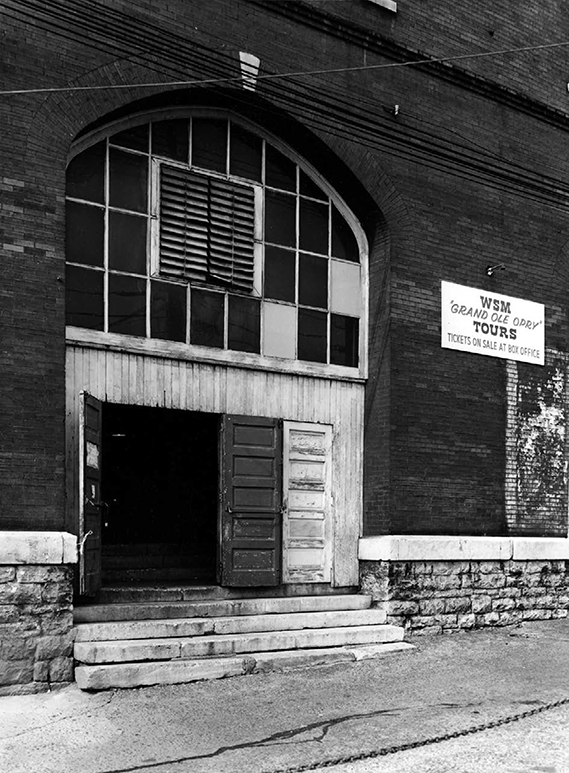
The Ryman’s stage was built in 1901, when a fund-raising committee, cooperating with the Nashville Philharmonic Society, helped to bring the Metropolitan Opera to Nashville—and a stage became a necessity. Completed, the stage was so big that it permitted the company to present The Barber of Seville on “the most elaborate scale.”5 It also reduced the building’s seating capacity to 3,500, but it gave Nashville an auditorium which could accommodate other opera companies, concert performers, and theater groups.
Further work was done on the stage in 1904, when the French Grand Opera Company of New Orleans came, and it was modified to provide dressing rooms and property storage in 1906, when Sarah Bernhardt appeared in Camille.6
Within the next few decades, Nashville audiences at the Ryman had heard the Chicago, the Boston, and the New York Symphony orchestras, as well as Sousa’s band and the U.S. Marine Band. Victor Herbert conducted his orchestra for the May Music Festival of 1903.
With the popularity of lyceums and chautauquas in 1904, the auditorium’s trustees contracted with the Rice Lyceum Bureau for a year’s series of lectures, music, readings, and entertainment. Paderewski appeared in 1907, as did William Jennings Bryan, Carrie Nation, and Emma Calve. Audiences at the Ryman heard lectures by Russell H. Conwell and Booker T. Washington, and Louise Homer, leading contralto of the Metropolitan Opera, appeared in concert. Helen Keller and her teacher Anne Sullivan Macy appeared in 1913, and Pavlova, Tetrazzini, and Alma Gluck came the following year. Galli-Curci sang in 1918; and in 1919, Paul Ryman, tenor, appeared in recital in the auditorium named for his father. Enrico Caruso sang there, the same year. Mischa Elman played the Ryman in 1920. Billy Sunday, Maurice Evans, Helen Hayes, Katherine Cornell, Maude Adams, Otis Skinner, Marian Anderson, Arthur Rubinstein, Bob Hope, Doris Day, and many other famous people have appeared there. Tex Ritter, Roy Acuff, Hank Williams, and Eddy Arnold centered their careers there.
The auditorium attained national prominence in the 1920s, when Nashville’s last legitimate theater was converted to a vaudeville and motion picture house, and the Ryman became the only place in the city where legitimate theater, concerts, and recitals could be held.7
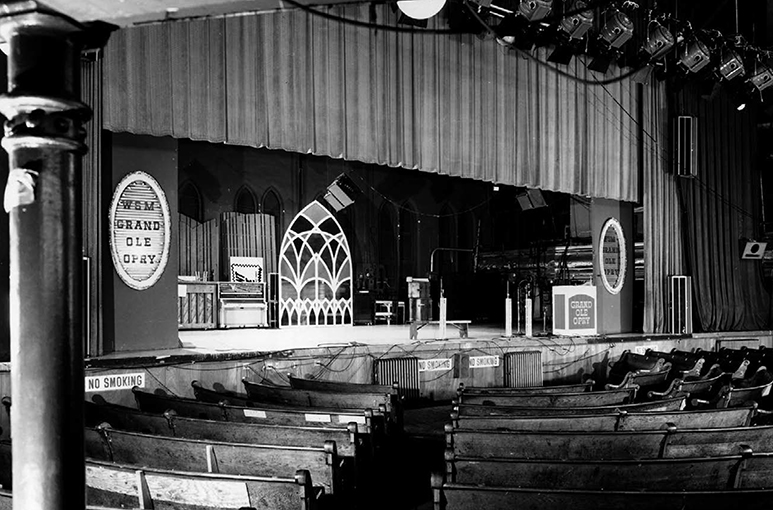
Beginning in 1941, the Ryman became the home of WSM’s Grand Ole Opry, after the country music show, established in 1925, had progressively outgrown rented quarters in studio after studio, and its crowds justified the move into “the largest house in Middle Tennessee.”8
Physical changes to the Ryman have been minor, and structural changes virtually unnecessary. The Gothic-revival structure has remained much the same as when it was built. The original pews and wooden floors remain. Lancet windows are spaced along the brick walls, and a buttressed effect appears at the corners and down the sides. The Louisville Bridge and Iron Company built the truss roof, which was outlined with trefoils on the stepped gables.9 In 1957, the building was sandblasted and cleaned, the wooden doors were replaced with aluminum and glass ones, and a new dressing room was built.
Some improvements have been made since National Life and Accident Insurance Company bought the auditorium. A new gas furnace was installed, and offices were added alongside the stage. For the taping of the Johnny Cash Show on television, the stage itself was modified. A removable stage and special lighting were added.
The future of the old auditorium is uncertain. The present owners plan to move the Grand Ole Opry to a new auditorium now under construction in Opryland, the company’s amusement-entertainment park along the Cumberland River. Announced plans were to raze the old Ryman and, as a sentimental salute to its eighty-odd years as a colorful part of Nashville’s cultural life, use part of the materials salvaged from it to build a Little Church of Opryland. Since a number of people and organizations, including the National Trust for Historic Preservation, would like to see the Ryman preserved, however, National Life and Accident Insurance Company decided to leave the decision about the Ryman’s future until a later time.
Notes
1. Ellen Beasley “The End of the Rainbow,” p. 21.
2. Jerry Henderson, “Nashville’s Ryman Auditorium,” p. 308.
3. Ibid., p. 317.
4. Beasley, “The End of the Rainbow,” p. 21.
5. Nashville American, October 23, 1901.
6. Beasley, “The End of the Rainbow,” p. 21; Henderson,
“Nashville’s Ryman Auditorium,” p. 326.
7. Beasley, “The End of the Rainbow,” p. 21.
8. Ibid.
9. Ibid.
Bibliography
Beasley, Ellen. “The End of the Rainbow.” Historic Preservation, 24, No. 1 (January–March 1972), 19–23.
Henderson, Jerry. “Nashville’s Ryman Auditorium.” Tennessee Historical Quarterly, XXVII (Winter 1968), 305–28.
Nashville, Tennessee. WSM Broadcasting Company. “History of the Grand Ole Opry House.”

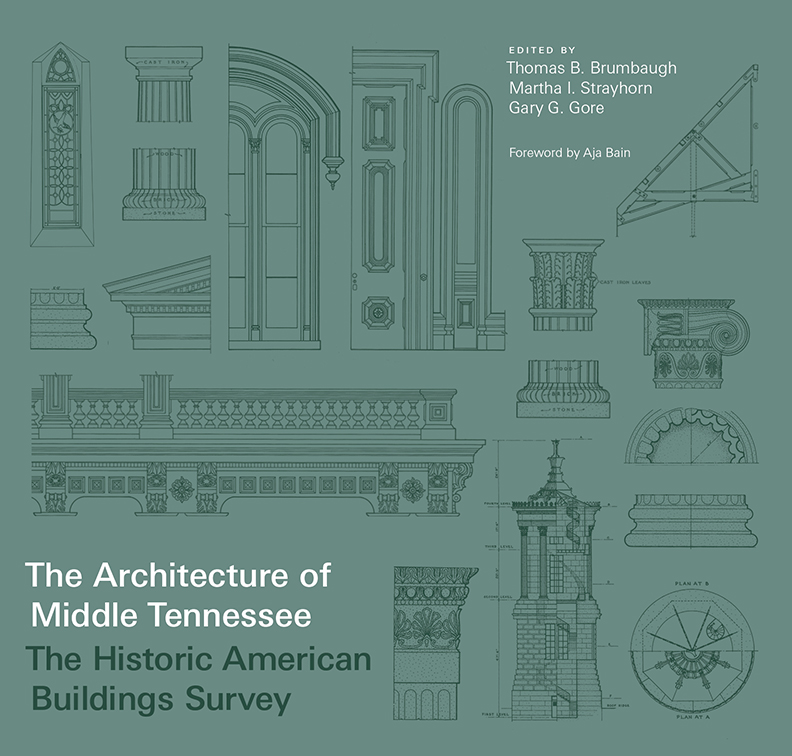
Leave a Response